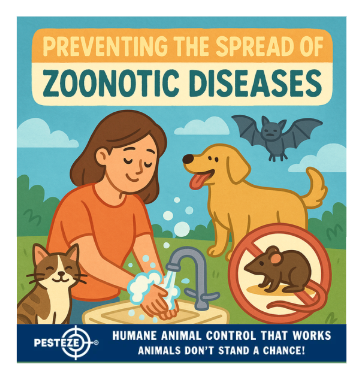PREVENTING THE SPREAD OF ZOONOTIC DISEASES

PREVENTING THE SPREAD OF ZOONOTIC DISEASES
SUMMARY
Zoonotic diseases are illnesses that can be transmitted between animals and humans. Preventing their spread requires awareness, hygiene, and responsible pet and wildlife management. This guide explains practical steps to reduce risks and protect both people and animals.
FEATURES
-
Understand the risks: Learn which diseases are most commonly spread.
-
Practice good hygiene: Wash hands after contact with animals.
-
Keep pets healthy: Regular vet visits and vaccinations are essential.
-
Handle wildlife safely: Avoid direct contact with wild animals.
-
Maintain clean environments: Proper waste disposal reduces pathogens.
-
Educate communities: Awareness helps prevent outbreaks.
GUIDE DESCRIPTION
Zoonotic diseases, such as rabies, salmonella, and ringworm, pose risks to both humans and animals. With the close interaction between people, pets, livestock, and wildlife, understanding how to prevent the spread of zoonotic diseases is critical for public health and animal welfare.
The first step is to understand the risks. Not all animals carry zoonotic diseases, but certain conditions—such as poor hygiene, lack of vaccinations, or contact with wildlife—can increase the chances of transmission. Knowing common diseases in your region helps you stay prepared.
Good hygiene practices are among the most effective defenses. Always wash your hands thoroughly after handling animals, cleaning litter boxes, or working outdoors. Disinfect surfaces where pets eat or sleep, and avoid sharing food with animals. Teaching children proper hygiene around pets is also essential.
Keeping pets healthy is another important factor. Regular veterinary visits, vaccinations, and parasite control prevent many diseases from developing or spreading. Flea, tick, and deworming treatments protect both pets and their owners. Sick pets should be examined by a veterinarian promptly.
When it comes to wildlife, the safest approach is avoidance. Do not handle wild animals, especially those that appear sick or injured, as they may carry diseases. If you must intervene—for example, if you find an injured wild animal—contact wildlife rehabilitators or animal control professionals rather than attempting to handle it yourself.
Maintaining clean environments also reduces risks. Dispose of animal waste properly, clean pet habitats regularly, and keep livestock areas free of standing water where mosquitoes and other disease carriers breed. Proper sanitation disrupts the conditions in which many zoonotic pathogens thrive.
Finally, community education plays a major role. Public awareness campaigns, school programs, and veterinary guidance help spread knowledge about prevention. When communities understand the importance of vaccinations, hygiene, and safe animal practices, the overall risk of outbreaks decreases.
By combining personal hygiene, responsible pet ownership, safe wildlife practices, and community education, the spread of zoonotic diseases can be greatly reduced. These efforts protect both human and animal health, creating safer and healthier environments for everyone.
- Saneeth Thota


Comments 0